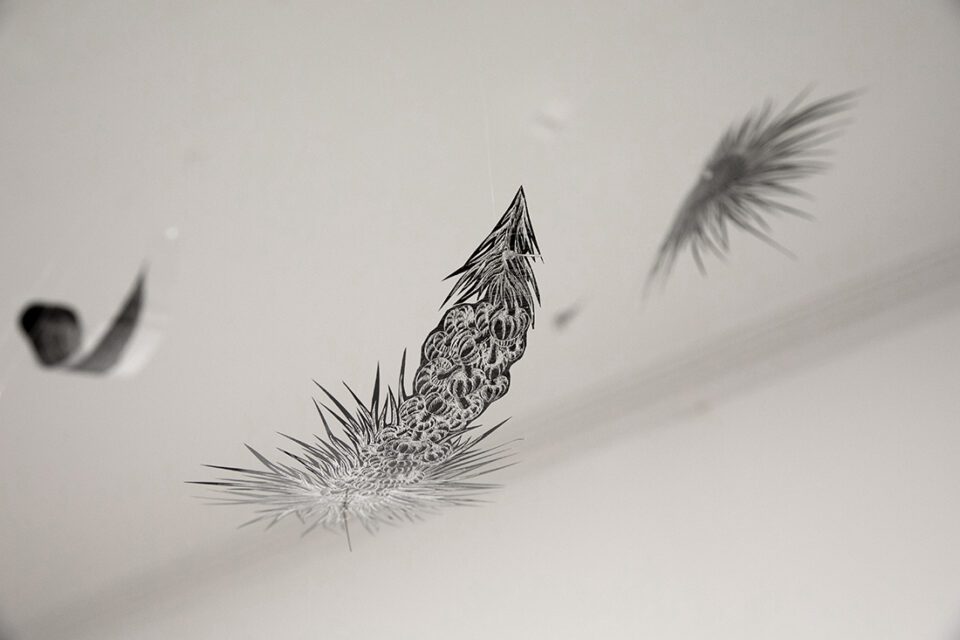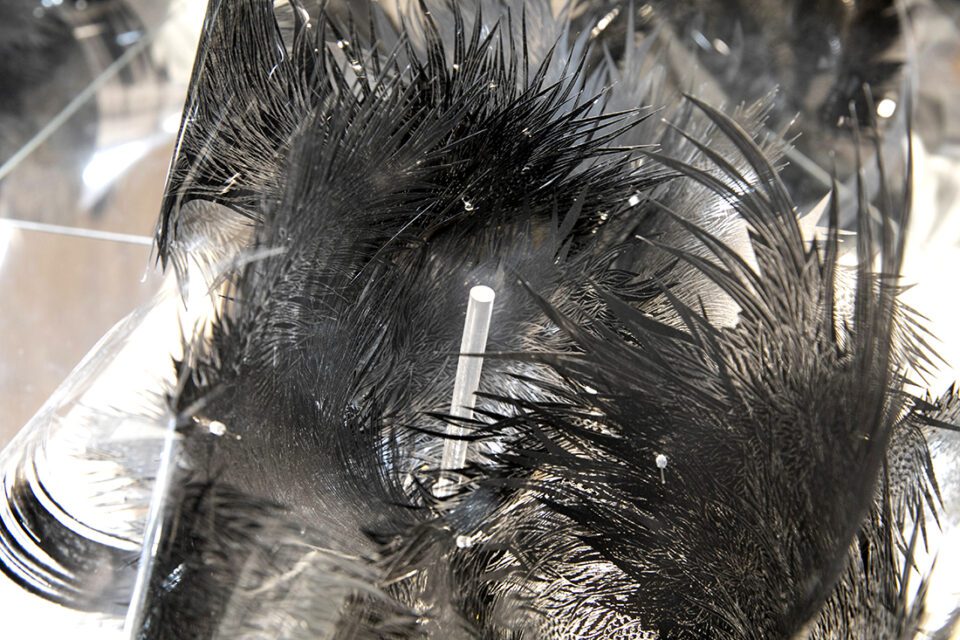Xiaowei Chen works in the USA and China. She is known for dense and intricate drawings in figuration and abstraction. Current focus is placed on large-scale drawings and sculptures which explore the interconnectivity between natural environments, disasters and human thought. Chen’s solo exhibition Endless Points is at AroundSpace Gallery in Shanghai until 30 December.
A: In issue 85 we present your Feather sculpture series – tell us about the materials used and why they are relevant to this particular expression of your art practice.
XC: I had been hoping that I could find a way to apply my technique of drawing on paper to sculpting. I tried many different kinds of flexible materials and eventually I found one method that was suitable for me. I apply paint on thin and flexible Plexiglass sheets then carve into them with submillimetre needle tools.
After cutting, bending and fixing in space, these drawings on Plexiglass are transformed to sculptures. The Feather series is my attempt of expanding my art from 2D to 3D. In addition to Plexiglass sheets of various thickness, I added LED lamps and mirror elements. They have the effect of illuminating and reflecting the drawings in space, which I think goes well with the idea that I set out to explore: freedom.
A: Your dense and intricate drawings were also presented. How do you find the inspiration and process of creating these works different from working on the Feather series?
XC: In my on-paper drawings, my goal is often to create something that is abstract and figurative at the same time. Visually, I want my drawings to appear abstract if viewed from afar and to reveal their hidden figures if viewed up close. It’s like walking into a jungle: your first impression of a perfect landscape is quickly overtaken by the existence of countless life forms, creatures and their life-and-death struggles. In making the Feather series, I draw inspirations from the same source, i.e. nature itself.
A: As a multimedia artist, is there a particular medium that you prefer? In what ways do different mediums express different themes?
XC: All my works are extensions of my on-paper drawings, including videos, sculptures, copper plates and performances I have made. When I am interested in a subject, I choose a medium that can convey my idea most expressively. To me, soft sculpture suits the concept of freedom, which itself is transformable and fluid in interpretation.
A: In what ways does your current practice visually explore the interconnectivity between natural environments, disasters and human thought? What initially drawn you towards this particular exploration?
XC: This may be related to my earlier experience as a director of documentary films. I got to interact with people from various backgrounds and social status. For example, on the simple question of how to deal with poverty and why there was poverty, there are countless answers given by people with very different perspectives.
I personally think that there is a causal relationship to everything, but not all choices are made with awareness or willingness. There may be underlining logic and mechanisms to what happens around us. In a way, the consequences are not that important. What did barbaric warfare mean to people who lived a hundred years later? What does destructive impact of a meteoroid on a planet make possible 100 million years later? The cosmos, nature, humans and other living organisms seem to have very similar and recurring behaviors and interrelated relationships.
I think in terms of of art we can think of macro and micro, figurative and abstract. I very much hope that my work can express this viewpoint, which may seem detached from reality. I also think in terms of fragmentation and group.
A: Are there any reoccurring motifs throughout your previous and current body of work?
XC: Anatomy and microanatomy of living or fossilised things appear in my works often, so I think they may have become motifs of a sort.
A: It has been some time since you did film and video work – are you planning to revisit this medium in future?
XC: I think I will. If I feel that I need to express what I want to express in the form of a short film, I will use film.
A: You are currently based in Boston and have exhibitions in China – tell us more about your plans.
XC: I currently have a solo exhibition at the Aroundspace Gallery in Shanghai. There are about 20 pieces of drawings and six sets of sculptures.
A: How often do you return to China? For how long do you usually stay? How do your visits and experiences in China influence the creation of your work?
XC: I usually decide the length of my stay in China based on the time required to complete a project or setting up an exhibition. The intervals of my visits are quite irregular. Going to places sometimes affects my art making in unexpected ways.
Sometimes I record what happened during my trips in writing or in photographs, such as meetings with interesting people. Once I was stuck in an aeroplane due to a delayed take-off, so I took out my drawing materials and began to work; I can work anywhere as I draw on small cards and then link them to form large-size pieces. The woman who sat next to me told me that she had never been to an artist’s studio or have any artist friends. Later I learned that she was an IT specialist. We had a very pleasant conversation and exchange of views. I am often richly rewarded by such chance encounters.
For further details about the Endless Points exhibition, click here.
Visit the artist’s website: www.xiaowei-art.com
The work of Xiaowei Chen appears in the Artists’ Directory in Issue 85 of Aesthetica. To pick up a copy, click here to visit our online shop.










